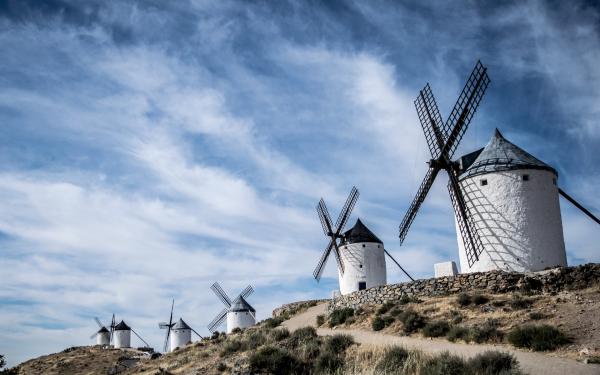Off-shore wind lasts longer and is stronger than on-shore, making off-shore wind farms (OWF) a source of renewable energy – except, of course, when it blocks your view, and those NIMBY (not in my backyard) types object. To be a valuable, efficient energy source, you need to cluster those turbines [1], and shallow water makes running the necessary lines for transmission and maintenance back to land more accessible. As it turns out, for the EU, the North Sea fits the bill, strong winds and relatively shallow water. Nearly 50% of the EU’s planned OWFs will be located there.
What about the free lunch?
Wind turbines extract some of the energy from the wind to create electricity, but like all our “engines,” it is not perfectly efficient. The energy lost in the conversion causes the downstream wind, the wake, to be both jumbled (turbulent), and slightly warmer by about 0.5°C. Warmer air is lighter, providing less force to turn the turbines, and turbulence “reduces the energy output and increases the load on wind farm structures and equipment” – a downside (dare I say downwind twofer?) Other studies have demonstrated that the wake from a wind farm can extend for 30 to 46 miles.
Bottom line – how you cluster your turbines, especially as we seek the efficiencies of wind-farm friendly sites like the North Sea, is one of the unanticipated costs of unbridled wind power.
The study
The researchers present their modeling of these atmospheric effects. Wind speed, direction, and seasonality data come from platforms already present in the North Sea. The changing response to the presence and absence of wakes was described as the capacity factor, CF, the optimum produced by the wind farms. As always, a model simplifies a problem, but the researchers tried to demonstrate that their model correlated in the upper 70 to lower 80% range with available data. Certainly, good enough to begin to draw some generalized insights.
“Our simulations show that the development of massive clustered OWFs significantly impacts the wind climate and efficiency of renewable energy production on a regional scale.”
- Reductions in annual mean wind speed up to 2-2.5 meters/second. Average wind speed in the North Sea is about 7.8 m/s [2]
- Turbulent air is increased about four-fold over the wind farms
- Wind speed reductions are more pronounced in the spring and summer, turbulence more pronounced in the autumn and winter
- Over a 10 km by 10 km wind farm, wind speed is reduced by 18%, and turbulence increases 7-fold.
- These changes result in a drop in capacity by 22%
Reduction in CF, the turbine’s capacity to produce energy, is also impacted by the direction of the wind and the distance between sites. But with a wake extending out for up to 30 miles or more, locating and clustering turbines becomes a more complex problem.
“We identified a trade-off in the clustering of off-shore wind farms. Clustering supports reduced energy production costs due to reduced infrastructure investments, but these advantages can be offset by wakes effects and the consequent reduction of CF. Our results emphasize that wind energy in the North Sea can be considered a limited resource.” [emphasis added]
Off-shore wind farms impact the local ecology, beneath the waves from the built environment and above by their effect on the wind. We should diversify our energy sources; the wind is a promising alternative. But to believe wind farms come at no or little ecologic cost is the same hubris that tells us to continue to burn, baby, burn those fossil fuels.
[1] Those clusters are considered “wind farms” as we harvest the bound of moving air. In reality, they could equally be called high technology factories, but then the pastoral, it's all good, vibe is lost.
[2] Analysis of wind speed observations on the North Sea coast Journal of Wind Engineering and Industrial Aerodynamics DOI: 10.1016/S0167-6105(97)00285-7
Source: Accelerating deployment of off-shore wind energy alter wind climate and reduce future power generation potentials Nature Scientific Reports DOI: 10.1038/s41598-021-91283-3




